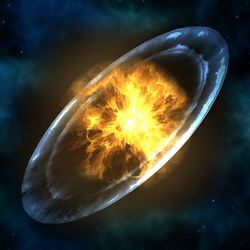How are large proton-rich atoms made in stars?
Except for the lightest, all atoms have been produced in stars, at different stages of stellar evolution, through various nucleosynthetic processes. The chemical elements heavier than iron are mainly produced by neutron induced nuclear reactions. However, There are a few dozen heavy and proton rich isotopes that cannot be created via neutron induced nuclear reactions seen during stellar evolution. These are the so-called p-isotopes. The p-process is one of the least understood processes of nucleosynthesis. P-process model calculations involve huge reaction networks and the rates of all the reactions are necessary inputs for the calculations. Model calculations have not been able to reproduce very well the abundances of p-isotopes observed in nature. One reason for this failure is insufficient knowledge of the nuclear physics required for the models. Experimental determination of the reaction rates from reaction cross-section measurements is therefore vital. The experimental database available for the p-process has lacked data on alpha-induced cross sections in the mass region of the heavy p-isotopes. The main goal of the ATOMKI-PPROCESS(opens in new window) (Nuclear reaction studies relevant to the astrophysical p-process nucleosynthesis) project was to investigate charged particle induced reactions in the mass and energy ranges of the p-process. Emphasis was put on nuclear reaction studies in this region. One of the most important and most uncertain nuclear input parameters for the calculations is the alpha-nucleus optical potential. This quantity can be studied experimentally with high precision elastic alpha-scattering experiments. Determination of the optical potentials by scattering experiments was the second main goal of the project. High efficiency gamma-detectors and modern nuclear electronics instruments were needed to make the planned cross section measurements possible. Researchers upgraded the scattering chamber used for elastic alpha-scattering experiments. In addition, they designed, built and tested a new target chamber for in-beam cross-section measurements. ATOMKI-PPROCESS members completed technically challenging storage ring experiments and gamma-induced reaction studies. In addition, high precision decay half-life measurements were carried out on the radioactive isotopes involved. Based on the scattering experiments, a new global alpha-nucleus optical potential has been suggested for astrophysical applications. Project data sets have made a significant contribution to the better understanding on the production of p-isotopes in the universe.




